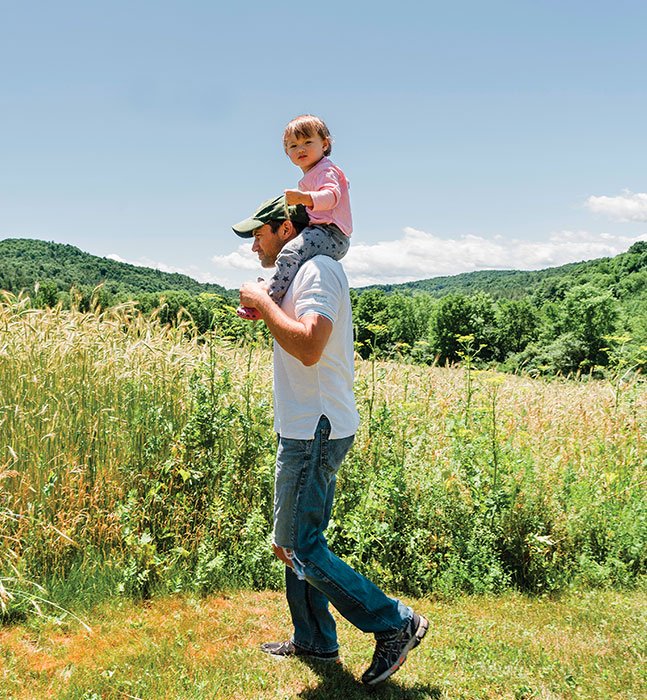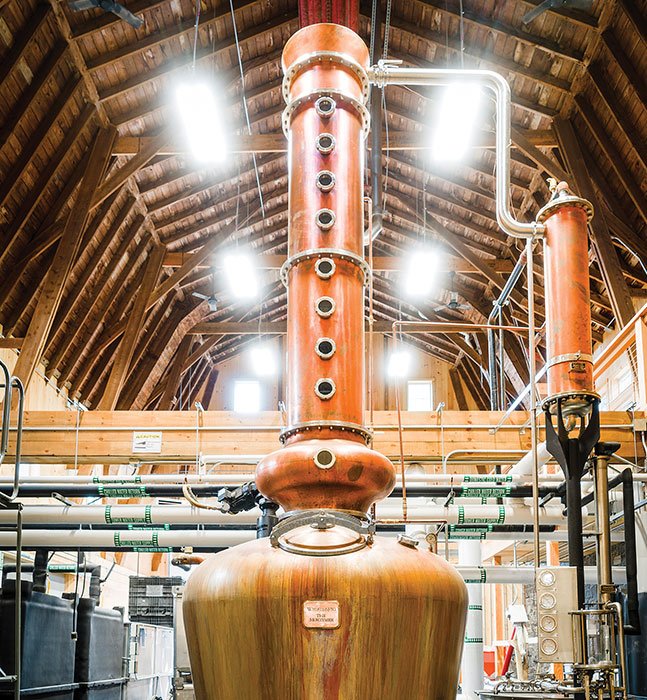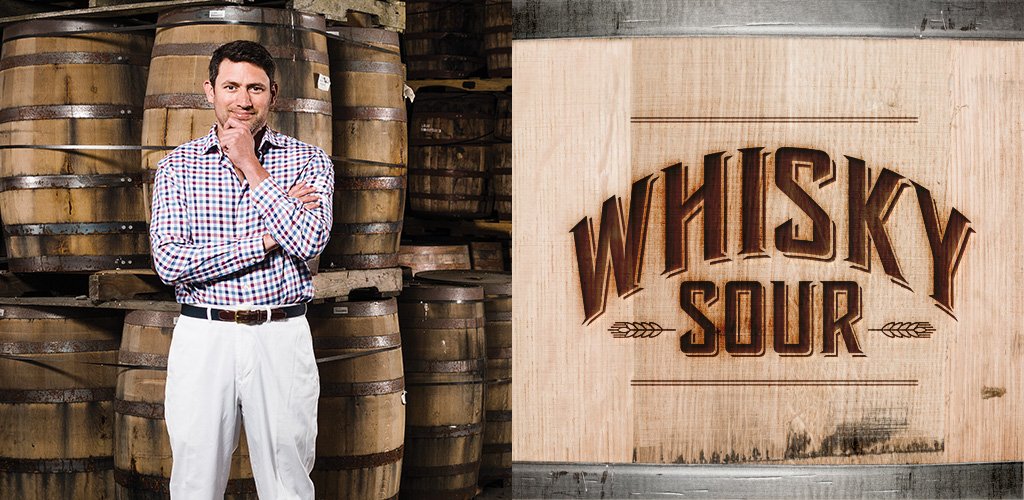On a clear morning in late April, the entrepreneur Raj Bhakta and his 3-year-old daughter, Vivian, hiked up Vermont’s Snake Mountain, a lonely peak that seems to rise out of nowhere in the middle of the countryside. From the summit at 1,287 feet, Bhakta pointed out the eastern shore of Lake Champlain, the Adirondacks in the distance and the red barn on his 1,300-acre farm some 12 miles away. That’s where he lives, and where WhistlePig, the 100 percent rye whisky brand he launched in 2010, operates. Vivian, however, was more intrigued by the vultures circling the trees below. As she tottered toward the edge of the mountain for a better look, she asked what the birds were doing. Bhakta held her back. “Babycakes, listen to me,” he warned. “If you go down there, you’ll die and those birds will eat you. That’s what a buzzard does, so you have to be careful. If you’re alive, they don’t do anything to you.”
Bhakta could just as easily have given himself that ominous advice. In only six years on the market, WhistlePig has established itself as a favorite craft brand, with prices to match: The best expressions sell for upwards of $400 a bottle. It has the name recognition, industry accolades and revenues that small craft distilleries dream of. But at a hastily called board meeting the week after this hike up Snake Mountain, two members voted to remove Bhakta as operating manager.

The two had been trying to get Bhakta to sell WhistlePig to a multinational spirits company. He refused, saying that he wants to continue building the brand as a family business, despite the chance to make about $50 million from a sale. Both sides have filed lawsuits, and Bhakta remains CEO while the issue is resolved in court. “Why am I fighting this?” he asks. “At a certain point, what’s the difference between having a few million or $50 million? I’m not caving in to the blackmail because this is my home.”
WhistlePig may be just a few years old, but it was able to tap into the resurgence of American spirits, which have enjoyed widespread popularity in recent years. Whiskies have become big business, with more than $1 billion in exports in 2015, according to figures from the Distilled Spirits Council, a trade association. Much of that success is due to bourbon and Tennessee whisky, which are made with corn. Rye whisky, while on a historic upswing—its volume grew 536 percent from 2009 to 2014—remains a smaller yet growing market segment, cherished by connoisseurs and mixologists for its complex taste, meticulous production process and national pedigree.

“American whisky is a cultural category—it’s got a rich history and heritage, and people buy into the story,” says Tommy Tardie, owner of the Flatiron Room, a Manhattan lounge with one of the country’s largest whisky lists. “Generally rye costs a little bit more because it’s more expensive to make—it needs to be aged longer, but people are willing to pay for it if they know what they’re getting.”

To drink rye whisky is to celebrate America, or so many a marketing campaign suggests, including WhistlePig’s, which tells the drink’s history under the headline, “For America, it has been a long road back to rye.” Distilling rye dates back to the Revolutionary War, when American colonists, facing a British embargo on molasses, could no longer produce rum. Among those whisky pioneers was George Washington, who had America’s largest rye distillery at his Virginia plantation, Mount Vernon. This last detail is a point of pride for WhistlePig, which makes note of it throughout its website.
Raj Bhakta is an unlikely farmer and whisky purveyor. The 40-year-old Philadelphia native grew up in the affluent suburb of Blue Bell, as his father, who emigrated from India in 1969, became a multimillionaire by building a small empire of car dealerships and, later, hotels. Bhakta attended Catholic schools—his mother was born in Ireland—and ultimately graduated from the Hill School, a boarding school in Pennsylvania favored by wealthy northeastern families; Donald Trump Jr. was among his classmates.
After graduating from Boston College in 1998 with degrees in economics and history, Bhakta struggled to find his way professionally, first working as an analyst for New York–based investment firm Violy, Byorum & Partners, then founding an online car-trading platform, Automovia, at 25. Automovia fell victim to the dot-com crash, leading Bhakta to work begrudgingly—for his father’s hotel business in Vail, Colo. Bhakta imitates his father’s complaints—and Indian accent recalling that time. “‘Did I raise a spoiled white boy? Is that what they teach you in boarding school?’ Between my dad driving me crazy and not having a dating life, I had to move on,” Bhakta says. That’s when his high school friend and college roommate Henry Harper suggested he apply for The Apprentice, the NBC reality show in which cast members competed in business-related tasks and were famously fired or hired by Donald Trump. Harper’s reasoning? “‘Your dad’s not going to think you ran away from the job because it’s a great opportunity, and it’ll solve your woman problem because you’ll be on TV.’”
Bhakta joined the second season of the show in 2004. He lasted nine episodes—and they were colorful. Bhakta made headlines when, during a tennis related challenge, he asked Anna Kournikova out on a date. Bhakta’s penchant for wearing bow ties and his urge to flirt with Trump’s secretary after being fired gave him 15 minutes of fame on talk shows and in tabloids, which he parlayed into a 2006 Republican bid for congress in Pennsylvania’s 13th district. “I’ve always been interested in public policy,” he says. It was a long-shot campaign against an incumbent candidate, and Bhakta did not win any points by being a former reality TV star and gossip column fodder or having DUI arrests on his record. Bhakta lost by a landslide 32 percentage points to Democrat Allyson Schwartz. “It was a really bad year to be a Republican,” he recalls. He now considers himself a “highly partisan independent.”
Bhakta landed in Vermont in 2007, using all his savings to buy a former dairy farm next door to buddy Henry Harper. The farm was also Harper’s suggestion; he thought it would stabilize Bhakta, still a hard-partying bachelor. “I liked the countryside, but I had absolutely no prospect for making this work,” he says. Facing bankruptcy, Bhakta hatched one more idea: “I wanted to make something on the farm that would be value-added agriculture. I knew that I needed to have a brand and charge a premium for the product because it would be handmade here. But I had no idea what it would be other than it was alcohol-related.”
Whatever it was, it would be called WhistlePig, which is Appalachian slang for groundhog. It was a word Bhakta had discovered while living in Colorado, when an erratic Frenchman he encountered during a hike repeatedly asked him, “Did you see the whistlepig?” before running off into the woods. The bizarre event had stuck with Bhakta, and he named the farm and his to-be-determined product after it. With some borrowed funds, he researched beer, vodka and whisky, ultimately settling on the category of rye.
Bhakta had help from investors, mainly family, but needed to figure out how to make the business profitable. Rye whisky needs to age for years to make it palatable—and marketable. And there are economies of scale to consider. “The vast majority of craft distillers lose money,” says Thomas Mooney, CEO of Portland, Ore.–based House Spirits Distillery and board member and former president of the American Craft Spirits Association, an advocacy group. “You need to get to a certain size to at least be able to afford the basics.” Rye, in particular, is a more labor-intensive grain to work with because it produces a bold, aggressive spirit that smooths out over longer periods of time. It also costs more than corn, which is used in most whisky and bourbon blends.
In late 2009, Bhakta hired Dave Pickerell, a former master distiller for Maker’s Mark, to help him. Pickerell located some aged supplies of rye whisky in Alberta, Canada, and recommended that they purchase those barrels, bottle the whisky on the farm and sell it under their own brand, giving them a product to immediately blend and sell while they worked on creating their own. It’s not an uncommon practice for a brand to source its whisky from other distillers; many known spirits brands such as Bulleit and Jefferson’s Bourbon operate in the same manner. “We’ve done such a great job to carefully curate the best old supplies of rye whisky in the world,” Bhakta says. “There are millions and millions of dollars of value once we sell that product.”
Bhakta’s ultimate goal was to have the first whisky company that grows, harvests, distills, ages and bottles its own rye. He would also harvest the oak from the trees on the farm to make his own barrels—a self-contained operation. Longer-term plans included the production of maple syrup and pork products and a philanthropic arm, the Progressive Farm Alliance, that would give loans to local farming entrepreneurs. Bhakta hoped this would be part of a multigenerational, family-owned business, in part because the campaign to release WhistlePig also had an unintended consequence: In 2010, Bhakta met Danhee Kim, a recent Columbia grad whom he hired as his executive assistant. Three years later, they would marry. “I was really lucky to meet her at the right point in my life,” he says.
WhistlePig launched in June 2010 to rave reviews, selling 1,000 cases of $70-per-bottle 10-year-old rye whisky. It earned high marks from publications such as Wine Enthusiast and the Wall Street Journal. By the end of 2011, sales had reached $1.3 million—a significant sum for a new whisky brand from rural Vermont. “That’s a really great first-year number,” Mooney says. “There are close to 2,000 craft distillers in the U.S., and the median craft distiller has revenue under $1 million. I’m sure other craft distillers have done more than that in their first year, but that certainly is better than most.” It was enough momentum to start seeking additional investors to raise capital.

Enter Dutch investment banker Wilco Faessen—one of the two board members now trying to oust Bhakta. A former colleague from Bhakta’s stint as an analyst, Faessen, now a managing director at Barclays concentrating on M&A, helped raise money and took a 15 percent stake in WhistlePig. He brought in another investor, Christopher Evison (the other board member), an investment banker who represents the billionaire Colombian American Santo Domingo family. The Santo Domingos’ estimated $15 billion wealth derives from businesses including multinational breweries and Colombian media outlets; they are the second largest shareholder in SABMiller, one of the world’s largest brewers, which is merging with Anheuser-Busch InBev—a deal Faessen helped to negotiate. Evison took a 12 percent stake in WhistlePig. According to legal documents, he and Faessen invested with the intent to sell the business to a “strategic acquirer” in the future. (Attorneys for Faessen and Evison declined to comment.)
Thanks to a combination of distiller Pickerell’s deft hand and well-known reputation in the industry, and Bhakta’s marketing instincts, WhistlePig is thriving. The brand revenue has grown 80 percent on average since its launch and has issued a number of well-received expressions including a 15-year-old whisky just released in May. In October 2015, WhistlePig opened its own distillery on the farm, a major step toward completing Bhakta’s vision of a seed-to-bottle operation.
The company’s success, of course, makes it ripe for takeover. Like many entrepreneurs, Bhakta is a colorful CEO, but Faessen and Evison go further in their suit, alleging that Bhakta has committed fraud, misappropriated company funds and is incapable of running the business. “We’ve been profitable from the beginning. I built a very good business. But very bad accusations are made of me in legal documents,” Bhakta complains. Faessen and Evison valued WhistlePig at $100 million, says Bhakta. Despite the $50 million a sale would give him, he is resolute in refusing.
“They want to sell WhistlePig to a foreign-based company that can pay more because of our U.S. tax structure”—which some critics argue promotes foreign ownership—“and be done with it,” Bhakta says, “despite the fact that I articulated all along that we wanted this to be a long-term, family-owned business.”
Bhakta argues that his fight against acquisition is about economic patriotism. “When you buy all your products and you know all the money goes abroad, do you want this?” he asks. But it’s clear that this is a personal struggle as well. “There is something bigger at stake,” he says. “Something more than the money.”








